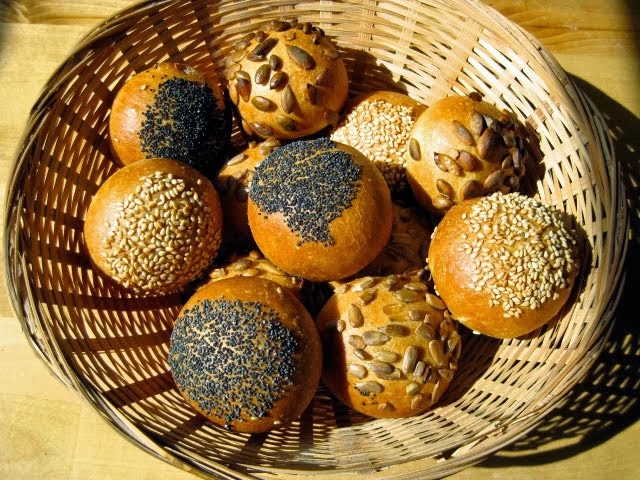Every German region has them, called "Rundstück" in Hamburg, "Schrippe" in Berlin, "Semmel" in Munich, or simply "Brötchen" (= little bread).
The typical Brötchen has a crackly crisp crust and a fluffy, soft, easy to pull out crumb. It has nothing in common with its soft, sweet and chewy US cousin, the dinner roll. And American Kaiser Rolls are just Kaisersemmel wannabes, they share only the pretty star cut with their Bavarian or Austrian ancestors.
 |
| Brötchen crumb should be soft, fluffy, and easy to pull out |
One of the greatest woes of German expats is the total lack of this everyday staple in the US.
No Brötchen to be found anywhere - perhaps bad imitations, but never the real thing.
And worse: no cookbook would even list a recipe!
In those days I had no clue about the differences between European and American flours.
I only knew they were categorized in a different way, European flours by their ash content (meaning what is left if you burn it) and American ones by their protein level.
One day we were shopping at our favorite Italian grocery, Micucci, in Portland. I saw Italian flour Tipo 00 on their shelves, and bought it, more out of curiosity then anything else. I remembered it listed as an ingredient in one of my most favorite bread baking books from a bakery in South Tyrol, Italy.
 |
| Different toppings to choose from |
In Ploner's "Brot aus Südtirol" I had finally found a recipe for Brötchen. I tried them several times, just assuming "Tipo 00" would be the same as all-purpose flour.
Frustratingly, every time the rolls turned out lean and chewy, more reminiscent of French bread.
But when I used the Italian flour, I finally nailed it: my rolls had the soft, fluffy, "pull-out" crumb typical for Brötchen.
Wikipedia told me why: US wheat has much more protein compared with European wheat.
Protein rich flour develops a strong gluten structure, so that the crumb is airy and chewy. Soft, low protein flours, like German Typ 405, or Italian Tipo 00, have much less gluten and bake into breads with a denser, fluffier crumb.
For an American/European flour "translation", click here.
I like a crunchy seed topping (as shown in the photos), but you can also give your rolls or a simple shiny, crackly glaze, so that they look like Rundstücke.
WEIZENBRÖTCHEN (adapted from Richard Ploner: "Brot aus Südtirol")
(12 rolls):
Dough
500 g/17.6 oz Italian Tipo 00 or pastry flour
8 g/0.3 oz instant yeast
4 g/1 tsp. sugar
270 g/9.1 oz water, lukewarm
40 g/1.4 oz olive oil
10 g/0.4 oz salt
Seed Topping
1 egg, slightly beaten, for brushing
sesame, poppy or sunflower seeds, for topping
OR
Shiny, Crackly Glaze
2 g cornstarch, boiled in
100 g water, and cooled to room temperature
In the evening, stir yeast into lukewarm water until dissolved. Mix all ingredients for 1 minute at lowest speed (mixer or wooden spoon). Let dough sit for 5 minutes.
Knead on medium-low speed (or with hands) for 2 minutes. Dough should be supple and still a little bit sticky (adjust with water if needed). Continue kneading for 4 more minutes, increasing speed to medium-high for last 30 sec. Dough should be very tacky, bordering on sticky.
 |
| Fold the dough like a business letter in thirds |
Transfer dough to lightly floured work surface. With wet or oiled hands, stretch and fold dough like a business envelope in thirds, then turn it around 90 degrees, and fold from short sides the same way.
Gather dough ball, sides tucked underneath, and place it in lightly oiled bowl. Cover, and let rest for 10 minutes. Repeat these stretches and folds 3 more times, every 10 minutes (40 min. total time)*.
Place dough in oiled bowl or container with lid (I divide it at this point in halves, and use 1-qt plastic containers). Roll dough around to coat all over with oil. Cover with plastic wrap or lid, and place in the fridge overnight.
*This technique is described in detail in Peter Reinhart's "Artisan Bread Every Day".
 |
| The dough is full of gas bubbles and has doubled |
DAY 2:
Remove dough from refrigerator 3 hours before baking, to de-chill and double their original size. Prepare egg wash and three bowls with sesame, poppy and sunflower seeds for topping. Line baking sheet with parchment paper.
 |
| Shape dough into 12 little rolls. |
Divide dough into 12 equal pieces, and shape them into rolls. Brush each with egg wash, then dip in seeds. If you prefer a shiny, crackly crust, skip egg wash (apply cornstarch glaze after proofing.)
Place dough balls seam side down on baking sheet. Let rolls rise ca 2 - 2 1/4 hours, or until grown 2 times their original size (remember to preheat oven after 1 3/4 hours.)
 |
| Ready for the oven |
Preheat oven to 428º F/220º C, including steam pan.
Brush proofed rolls with cornstarch glaze (if using). Place rolls in oven, pouring 1 cup boiling water in steam pan.
Bake for 9 minutes, then re-brush with cornstarch glaze (if using), rotate baking sheet 180 degrees for even browning, and continue baking for another 9 - 10 minutes, or until golden brown (internal temperature at least 200º F/92º C).
Leave rolls in switched off oven for 10 minutes more (leave door a crack open), before taking them out to cool on a rack.
BreadStorm users (also the free version) can download the formula:
Freerk of BreadLab made a very nice video clip of how to make these rolls - view it at YouTube.
And check out Joanna's Brötchen post at Zeb Bakes, one of my favorite blogs with great breads and lovely photos.
Ian, from Mookie Loves Bread made the rolls with fruit yeast water and a toasted onion, black sesame, Asiago cheese and flaxseed topping.

Comments
Post a Comment